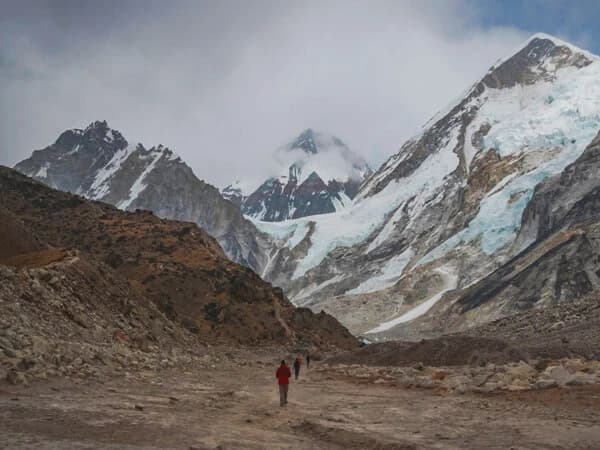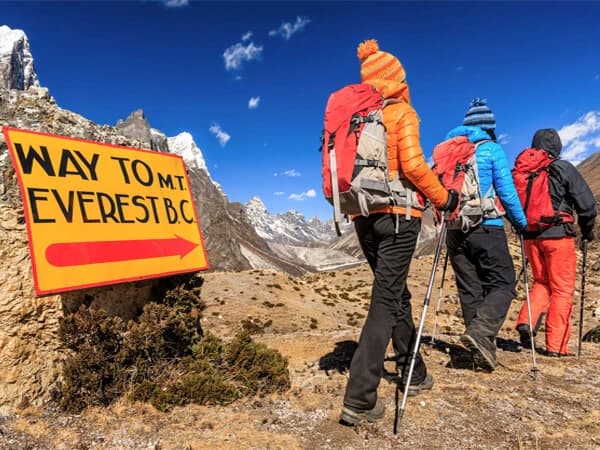Everest view trek permit and fee
The Everest view trek requires two permits. They are the Khumbu Pasang Lhamu Rural Municipality Entrance permit and the Sagarmatha National Park Entry permit. You can get these permits at the Nepal Tourism Board Office or Lukla/Monjo. Our package cost covers these permit fees, so you do not have to pay extra money. Likewise, our team will obtain the permits on your behalf.
- Khumbu Pasang Lhamu Rural Municipality Entrance permit cost: NPR 2000 per person
- Sagarmatha National Park Entry permit cost: NPR 3000 per person
Guide and porter during the trek
You will do the Everest view trek with a native guide and porter. You are most likely to meet your guide in Kathmandu, whereas the porter will join you in Lukla. All of our guides can speak and understand English. We make sure they can communicate in your language if you are not comfortable with English.
Our mountain guides hold numerous years of expertise, so you can rely on them during the trek. They are also trained for first aid and remote survival. With their expertise, you can trek in the Everest region freely. Our guides are also friendly and quite fun to be around. They will also help you interact with the locals and share interesting facts about the region.
What is the best time to do the Everest view trek?
The best time to do the Everest view trek is March, April, and May (spring) and September, October, and November (autumn). Likewise, June, July, and August (summer/monsoon) and December, January, and February (winter) are the off-seasons. Regardless, you can do the Everest view trek throughout the year if you plan it well.
Trekking during spring and autumn allows for favorable weather and climate. You are less likely to come across Lukla flight delays/cancellations or any weather-related issues in these seasons. Similarly, the mountain views are fantastic, and the trail condition is also great. The thriving vegetation makes the trail enchanting.
Travel insurance for the Everest view trek
To do any trek in the Everest region, you have to get travel insurance with helicopter evacuation coverage. It is to protect yourself against any unforeseen circumstances you may come across during the trip. Helicopter evacuation up to 4,000 meters is necessary for the Everest view trek.
We also recommend adding medical bills, flight cancellations, and loss/theft of your personal belongings to the travel insurance. Trekking in the Himalayas usually comes under adventure sports coverage, and some standard travel insurance policies may exclude it. So, verify your travel insurance covers trekking at high altitudes.
What is the altitude sickness risk on this trek? How to avoid it during the Everest view trek?
Altitude sickness or acute mountain sickness (AMS) happens during trekking in the Himalayas because of high elevation. Trekkers usually suffer from it if they do not acclimatize. It is common, treatable, and available as well. The Everest view trek has a very low risk of altitude sickness.
Our Everest view trek itinerary is designed keeping acclimatization in mind. Descending to Phakding on the day you fly to Lukla is your first acclimatization move. Similarly, in Namche Bazaar, you will hike to a high altitude and return to sleep at a low. This also helps you in acclimatization.
Headache, vomiting, difficulty in breathing, nausea, insomnia, etc are some early symptoms of altitude sickness. If you see any of it, inform your guide. Likewise, follow the below tips to prevent altitude sickness during Everest view trekking:
- Stay hydrated. Drink at least 2 liters of water every day.
- Take your time to ascend and enjoy the surroundings. Do not rush.
- Maintain a balanced diet rich in carbohydrates. Eat easily digestible meals and snacks.
- Take frequent breaks, and do not overexert yourself.
- Listen to your body. If you feel sick, inform your guide and take the necessary medicines.
- Do not drink alcohol or smoke, as they impair your body's ability to acclimatize.
Accommodation and meals during the Everest view trekking
The accommodation during the Everest viewtrek in Nepal is a hotel and lodges. In Kathmandu, you will spend nights in nice tourist standard hotels. As per our Everest view trek itinerary, you will spend four nights in Kathmandu. Likewise, along the trek route, lodges will be your accommodation.
Let us know if you are fine with twin-shared rooms or need single rooms during booking. The lodges will be simple but clean and cozy to spend the night. You may get a private washroom, but it’s not guaranteed. Similarly, you can also upgrade your accommodation to a luxury lodge.
In Kathmandu, our package covers two complimentary dinners and all breakfasts. rest of the meals, you have to manage by yourself. Likewise, during trekking, you get three meals (breakfast, lunch, and dinner). The meals are provided as per the menu of the lodges.
During the Everest view trek, you will explore the three most developed villages in the entire Khumbu region: Lukla, Phakding, and Namche Bazaar. So, the food menu will be fantastic. From typical dal bhat, momos, thukpa, noodles, Sherpa stew, and thenduk to pizza, burgers, sandwich, steaks, and pasta, you will get everything.
How to book the Everest view trek in 2024-2025 and what is the cancellation/refund policy?
To book the Everest view trek for the year 2024 or 2025, you can use our website or contact our team. To book via the website, select your preferred trek departure date, fill in your general information, and make advance payment for booking. If you wish to make any changes to the itinerary or services, get in touch with us.














